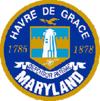Havre de Grace Elementary School
| Havre de Grace, Maryland | ||
|---|---|---|
| City | ||
| City of Havre de Grace | ||

Concord Point Lighthouse, The Iconic Representation of HdG. Sits at the mouth of the Susquehanna River in Havre de Grace
|
||
|
||
 Location in Maryland |
||
| Coordinates: 39°32′54″N 76°5′51″W / 39.54833°N 76.09750°WCoordinates: 39°32′54″N 76°5′51″W / 39.54833°N 76.09750°W | ||
| Country | ||
| State |
|
|
| County |
|
|
| Incorporated | 1785 | |
| Government | ||
| • Mayor | William Martin | |
| Area | ||
| • Total | 6.89 sq mi (17.85 km2) | |
| • Land | 5.50 sq mi (14.24 km2) | |
| • Water | 1.39 sq mi (3.60 km2) 20.17% | |
| Elevation | 56 ft (17 m) | |
| Population (2010) | ||
| • Total | 12,952 | |
| • Estimate (2016) | 13,527 | |
| • Density | 1,900/sq mi (730/km2) | |
| Time zone | Eastern (UTC-5) | |
| • Summer (DST) | Eastern (UTC-4) | |
| ZIP code | 21078 | |
| Area code(s) | 410 | |
| FIPS code | 24-37600 | |
| GNIS feature ID | 0590437 | |
| Website | www.havredegracemd.com | |
Havre de Grace /ˌhævər dɪˈɡreɪs/, abbreviated HdG, is a city in Harford County, Maryland, situated at the mouth of the Susquehanna River and the head of Chesapeake Bay. It is named after the port city of Le Havre, France, which in full was once Le Havre de Grâce (French, "Harbor of Grace"). The population was 12,952 at the 2010 United States Census. The city was honored as one of America's 20 best small towns to visit in 2014 by Smithsonian magazine.
During the Revolutionary War, the small hamlet known as Harmer's Town was visited several times by General Lafayette, considered a hero of the war. He commented that the area reminded him of the French seaport of Le Havre, which had originally been named Le Havre-de-Grâce. Inspired by Lafayette's comments, the residents incorporated the town as Havre de Grace in 1785.
During the First Congress in 1789, Havre de Grace missed by only one vote being named the capital of the fledgling United States.
On May 3, 1813, during the War of 1812, Havre de Grace was attacked by British Rear Admiral George Cockburn who burned and plundered the city. The American Lieutenant John O'Neill single-handedly manned a cannon to help defend the town. He was wounded, captured by the British, and soon released. In gratitude, Havre de Grace made O'Neill and his descendants the hereditary keepers of the Concord Point lighthouse marking the mouth of the Susquehanna River.
...
Wikipedia

